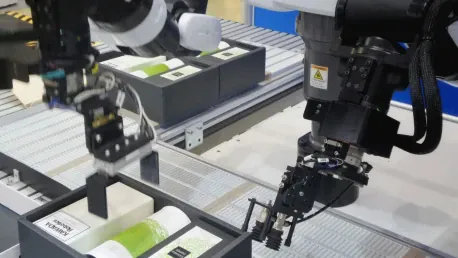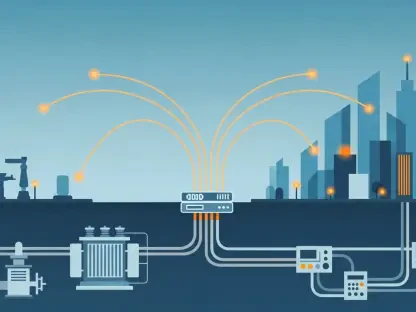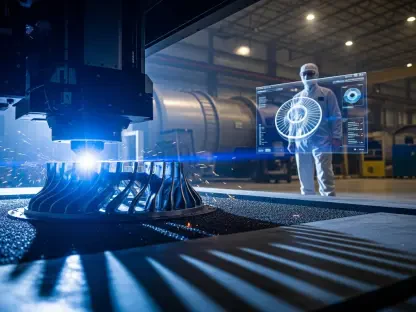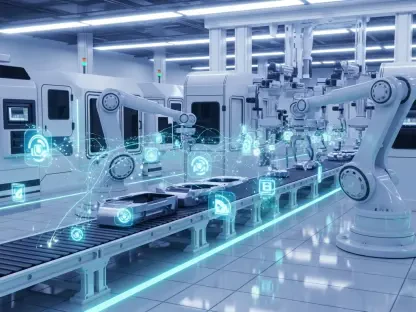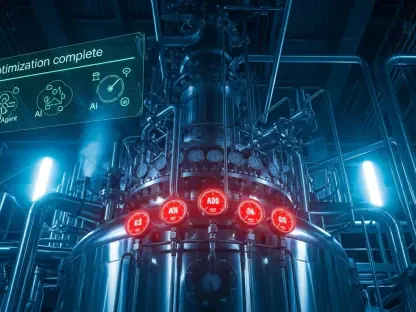Automation is significantly transforming various industries across the globe, especially the packaging sector, which is experiencing major advancements with the rise of robotics and AI integration. This technological evolution offers businesses efficient solutions, helping them stay competitive in a rapidly changing environment. The integration of collaborative robots (cobots) and AI-powered systems brings unprecedented opportunities for increased productivity while also addressing the concerns and challenges faced by the sector.
Evolution of Robotics in Manufacturing
The historical context of robotics in manufacturing highlights its remarkable development over the past few decades. In the early 1980s, robotics in industries were quite limited and rudimentary. Professor Mike Wilson, chief automation officer at the Manufacturing Technology Centre (MTC), recalls his early experiences at British Leyland’s Cowley factory in Oxford, where robotics was nascent. At that time, the factory had only two robots. Fast forward to the present, and the same factory employs over 1,000 robots. This growth underscores the transformative power of automation over a relatively short period.
Initially, robots in the 1980s were too slow and lacked the precision necessary for packaging applications. Hydraulic robots were commonly used to handle heavier equipment. Today, advancements have led to high-speed robots of various sizes and shapes capable of working alongside humans. The introduction of AI-powered vision systems has improved robotic capabilities, making them faster, more accurate, and more versatile.
The evolution of robotics didn’t happen overnight; it took decades of research, development, and continuous improvements. From bulky hydraulic systems to sleek, efficient, and highly precise AI-powered machines, the technology has come a long way. Robots now perform tasks that were previously unimaginable, including intricate labeling and delicate packaging without human intervention. The increased adoption of high-speed robots in packaging has boosted productivity and led to more consistent quality in products. The combination of AI and robotics allows machines to learn from their environment and make real-time adjustments, ensuring optimal performance at all times.
Addressing Fears and Misconceptions
Despite these advancements, integrating robotics in labels and packaging has faced challenges, particularly misconceptions about job displacement. The fear that robots will replace human jobs has been amplified by popular media and science fiction. However, Professor Wilson explains that robots often take over tasks that are dirty, dangerous, and physically demanding, which humans should ideally avoid. Instead of eliminating jobs, automation can enhance employment by creating roles that require more skill and creativity. Wilson draws parallels with the finance industry, where the introduction of ATMs did not eradicate banking jobs but rather led to more skilled employment opportunities.
Robots should be viewed as advanced tools of automation, designed to optimize efficiency and augment human capabilities, not as threats to employment. They allow humans to focus on higher-value tasks that require critical thinking, problem-solving, and creativity. As businesses adopt robotics, they can offer employees opportunities for upskilling, turning the fear of job loss into a chance for career advancement and personal growth. The transformation seen in other industries where automation was initially feared, like finance, serves as a blueprint for the packaging sector to follow.
By addressing these misconceptions, the industry can shift the narrative towards recognizing the benefits of robotics. This includes improving working conditions by reducing human exposure to hazardous tasks and enhancing overall job satisfaction by allowing workers to engage in more meaningful activities. Emphasizing training and development as part of automation rollouts ensures employees are not left behind but are, instead, a key part of the industry’s evolution.
The Rise of Collaborative Robots
A prominent trend in the robotics industry is the increasing popularity of collaborative robots or cobots. Cobots are designed to work alongside humans in shared spaces without necessitating extensive guarding and infrastructure typical of traditional industrial robots. Cobots are easier to install, offer greater flexibility, and can be repositioned within factories as needed. This makes them particularly appealing for small and medium-sized enterprises (SMEs), which are prevalent in the UK’s manufacturing landscape.
Professor Wilson notes that despite the potential for human-robot collaboration, most cobots today operate independently rather than in direct conjunction with human workers. Moving forward, he envisions scenarios where humans and robots collaborate more closely on shared tasks. Cobots are equipped with advanced sensors and AI algorithms that allow them to detect human presence and respond appropriately, ensuring safety while maintaining efficiency.
The rise of cobots represents a significant shift in how automation is perceived and implemented. Unlike traditional robots that are often isolated behind safety barriers, cobots bring flexibility and simplicity, making automation accessible to businesses of varying sizes. Their ability to adapt to different tasks and environments quickly means that SMEs can utilize cobots to increase productivity without incurring substantial infrastructure changes. The cost-effectiveness and adaptability of cobots present an attractive automation solution, encouraging businesses hesitant about traditional robots to consider investing in robotics technology.
Cobots’ integration into packaging processes exemplifies the future of manufacturing, where human and robot collaboration enhances performance. SMEs leveraging cobots can achieve significant improvements in production speed and product quality, ensuring they remain competitive in a global market. As cobot technology evolves, so will the opportunities for more complex and integrated workflows between humans and machines.
The Future of Humanoid Robots
Interest in humanoid robots is growing, especially in China and the US, where these robots are designed to mimic human capabilities and interact closely with people. However, Wilson remains skeptical about the impact of humanoid robots on manufacturing. He argues that for most manufacturing processes, standard robots can efficiently handle tasks without needing the added complexity of humanoid robots. Humanoid robots may be more relevant in sectors requiring direct human interaction, such as healthcare or hospitality, rather than manufacturing.
While the concept of humanoid robots is intriguing, their application in packaging processes may not be practical or necessary. Standard industrial robots are already highly capable of performing repetitive and precise tasks, often more efficiently than a humanoid could. The appeal of humanoid robots lies in their potential to perform a wider variety of tasks due to their human-like structure and dexterity, but this comes with higher costs and complexity. Manufacturing environments, unlike social spaces, do not typically require the nuanced interactions and adaptability that humanoids aim to provide.
For industries focusing on packaging, the emphasis remains on optimizing efficiency, speed, and accuracy, areas where traditional and collaborative robots excel without the need for additional human-like features. The innovation in robot design continues to center on enhancing specific functionalities that directly contribute to production goals, such as faster processing times, better adaptability, and seamless integration with AI systems. The future of robotics in packaging is likely to see more refined versions of existing technologies that offer even greater precision and collaboration with human workers.
Overcoming Barriers to Adoption
Several barriers continue to impede the widespread adoption of robotics in the packaging sector. The flexibility of the labor market in the UK, where short-term contracts and agency workers are common, has historically discouraged investments in capital-intensive equipment like robots. Recent factors, such as labor shortages, rising employment costs, and government policies (e.g., increases in national insurance and the minimum wage), are now shifting this dynamic and making automation more attractive.
The perceived high cost of automation equipment is another barrier. While robots are not inexpensive, Wilson maintains that they are more affordable than many businesses realize. The cost of implementing a collaborative robot on a production line can be less than that of a moderately sized family car. To make automation more accessible, businesses need suitable financing options such as leasing or rental schemes. By spreading out the costs, companies can invest in robotics without significant upfront expenditures, making it a viable option even for smaller enterprises.
Overcoming these barriers involves a comprehensive approach that includes financial support, government incentives, and targeted industry training programs. Policymakers can play a crucial role by providing subsidies or tax breaks for companies investing in advanced manufacturing technologies. Additionally, educating business leaders about the long-term benefits and return on investment from robotics can help shift the perception of high initial costs. As more companies successfully adopt automation, industry case studies and evidence of positive outcomes will further encourage widespread adoption.
Businesses that overcome the initial financial and operational hurdles often find that the benefits of automation far outweigh the challenges. Increased productivity, reduced human error, and the ability to operate continuously without fatigue are significant advantages that contribute to a positive cost-benefit analysis. Addressing the barriers to adoption with strategic support and education can facilitate a smoother transition toward higher levels of automation in the packaging sector.
Importance of Skills and Training
A critical challenge in adopting robotics is ensuring businesses possess the skills to operate and maintain the equipment. Many companies lack the expertise required for robotic installation and operation. Structured training and upskilling opportunities are essential to help businesses navigate the steep learning curve associated with their first robotic installation. Developing a skilled workforce that is proficient in robotics technology is crucial for the successful integration of automation. This requires a commitment from both the industry and educational institutions to provide relevant training programs.
Younger generations, having grown up with technology, are generally more receptive to robotics and may find automation less daunting. This demographic shift could facilitate the integration of robotics as younger workers enter the workforce and prefer engaging, high-value tasks over repetitive ones, thus pushing businesses toward automation. By investing in training and education, companies can ensure their employees are not only comfortable with robotics technology but also capable of optimizing its use to achieve operational excellence.
It is also vital for companies to create a culture that embraces continuous learning and innovation. Providing ongoing training and development opportunities helps employees stay updated with the latest technological advancements and enhances their problem-solving skills. Partnerships between companies and educational institutions can bridge the skills gap, offering internships, apprenticeships, and specialized courses tailored to industry needs. By empowering their workforce with the necessary skills and knowledge, businesses can maximize the benefits of automation and ensure long-term success.
Navigating Geopolitical and Economic Shifts
External factors such as geopolitical tensions, supply chain disruptions, and events like the Covid-19 pandemic are driving businesses to reevaluate their manufacturing strategies. These events have exposed the vulnerabilities of global supply chains and prompted considerations for reshoring and nearshoring. Brexit has complicated cross-border trade with the EU, pushing businesses to explore automation as a means to increase resilience and maintain competitiveness. By adopting advanced robotics and AI technologies, companies can mitigate risks associated with external disruptions and improve their operational flexibility.
The adoption of automation enables businesses to adapt to changing market conditions more swiftly, ensuring they can continue to meet customer demands despite challenges. AI-powered systems can analyze market trends and predict potential disruptions, allowing companies to proactively adjust their strategies. Automation also enhances the ability to scale operations up or down quickly, providing a competitive edge in fluctuating economic environments. The integration of robotics into packaging processes ensures consistent quality and reduces dependency on external labor markets, further strengthening resilience.
Moreover, as global trade policies and economic conditions continue to evolve, automation offers an avenue for businesses to streamline their operations and reduce costs. By investing in robotics, companies can achieve greater efficiency and cost savings, enabling them to navigate economic uncertainties more effectively. The ability to maintain stable production levels and ensure product quality despite external pressures positions businesses for long-term success in a competitive global market.
Creating a Technology Plan
Wilson emphasizes the need for businesses to view automation as a strategic investment akin to having a business plan. A technology plan should identify relevant technologies that offer competitive advantages and outline a step-by-step strategy for implementation, taking into account training, financing, and long-term goals. By systematically approaching automation, businesses can better prepare for future challenges and opportunities, ensuring they stay ahead of the curve.
A well-crafted technology plan includes assessing the current state of operations, identifying areas where automation can have the most significant impact, and setting clear objectives. It also involves evaluating the potential return on investment, considering both financial and operational benefits. By aligning the technology plan with broader business goals, companies can ensure that their automation efforts contribute to overall growth and success. Regularly reviewing and updating the plan based on technological advancements and industry trends ensures that businesses remain adaptable and responsive to changing needs.
Implementing a technology plan requires collaboration across various departments, including IT, operations, and human resources, to ensure a seamless transition to automated processes. Establishing a dedicated team to oversee the implementation and address any challenges that arise is crucial for maintaining momentum and achieving desired outcomes. By taking a strategic and collaborative approach to automation, businesses can unlock the full potential of robotics and AI, driving innovation and efficiency in the packaging sector.
Conclusion
Automation is making a significant impact on a variety of industries worldwide, with the packaging sector witnessing some of the most considerable advancements due to the emergence of robotics and AI integration. This technological evolution is providing businesses with highly efficient solutions that enable them to stay competitive in a fast-changing market landscape.
The incorporation of collaborative robots (cobots) and AI-powered systems within the packaging industry is opening up new opportunities for increased productivity like never before. Cobots, designed to work alongside human employees, are improving workflow efficiencies, reducing errors, and allowing for more precise operations. AI-powered systems further enhance these advancements by offering intelligent data analysis, predictive maintenance, and adaptive learning capabilities, enabling companies to optimize their operations continuously.
Along with the benefits, this transition also addresses several challenges the packaging sector faces, such as labor shortages and the need for greater flexibility and customization in production processes. By embracing automation, packaging companies can ensure they meet the growing demands for faster production times and higher quality standards without sacrificing workforce safety.
Overall, the integration of robotics and AI in the packaging industry is not just a trend but a vital shift towards a more innovative and sustainable future. This transformation empowers businesses to thrive in an increasingly competitive and technologically driven environment, ensuring ongoing growth and efficiency.
